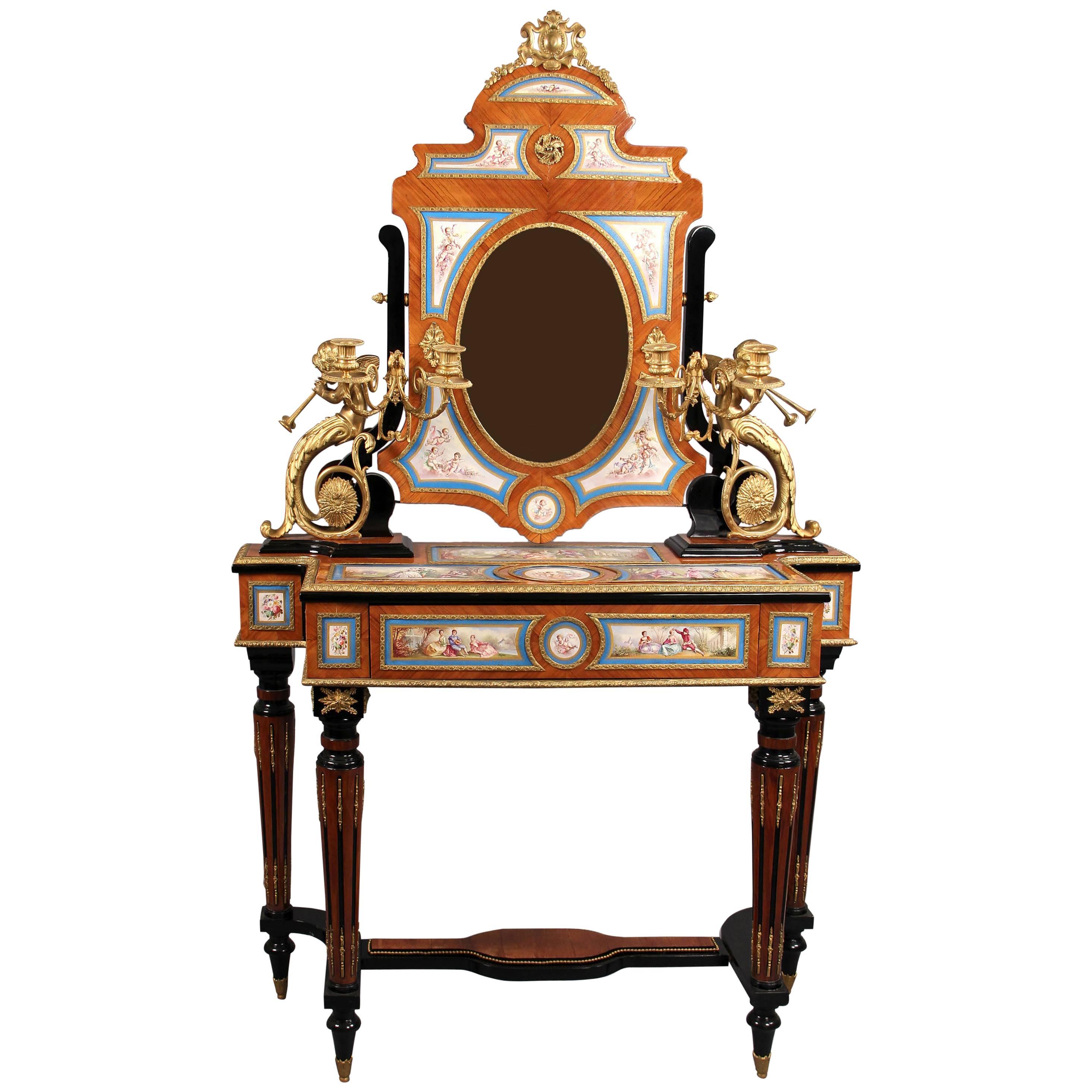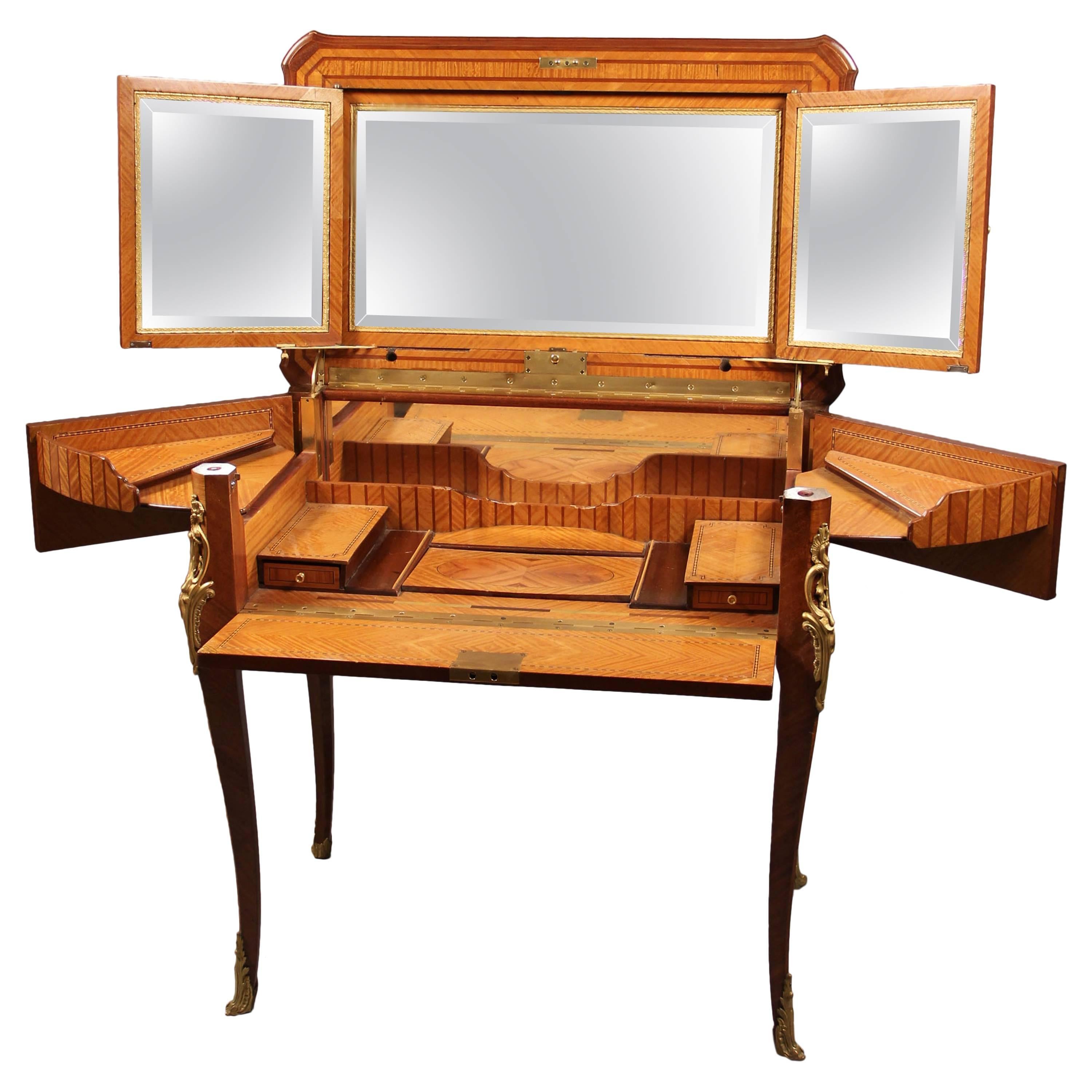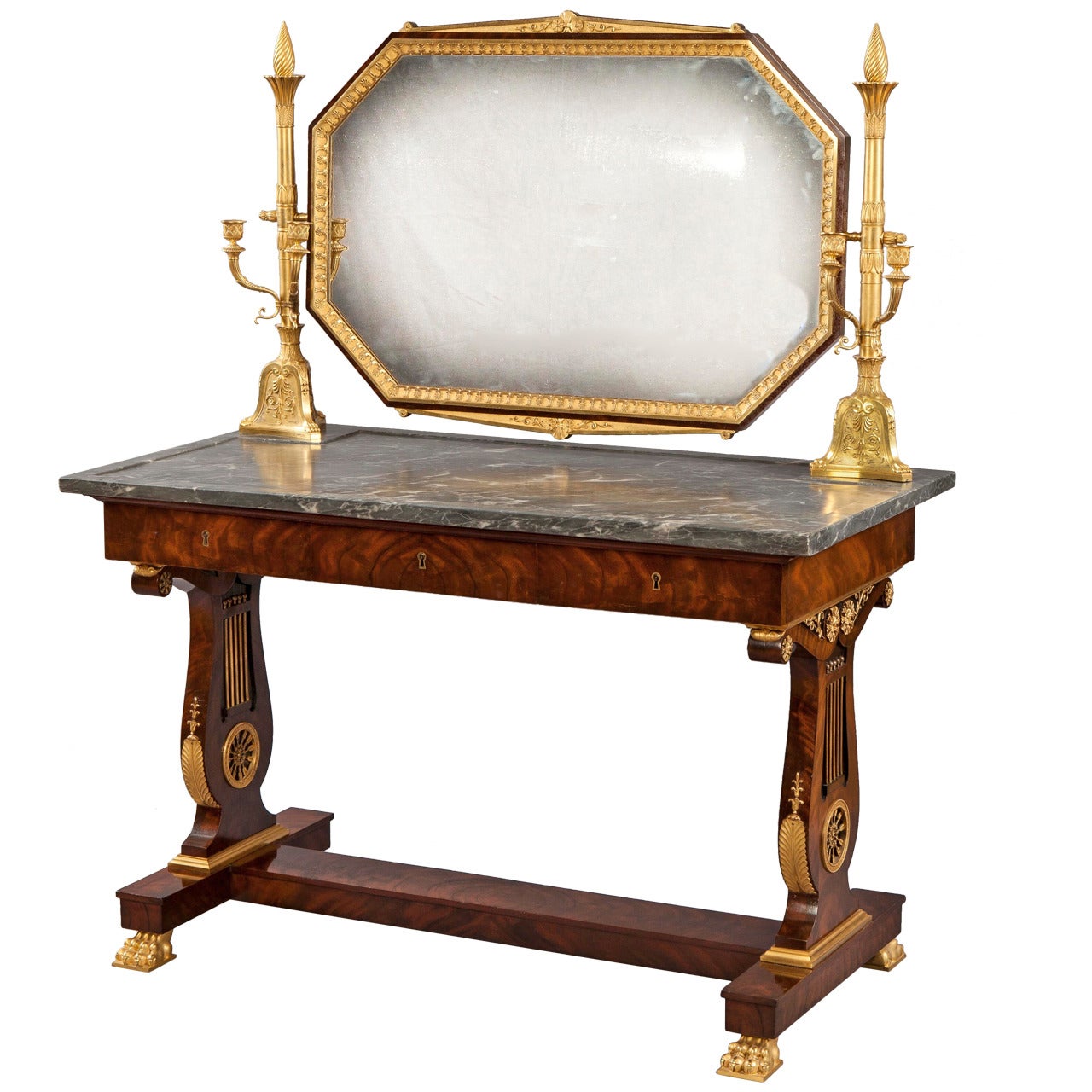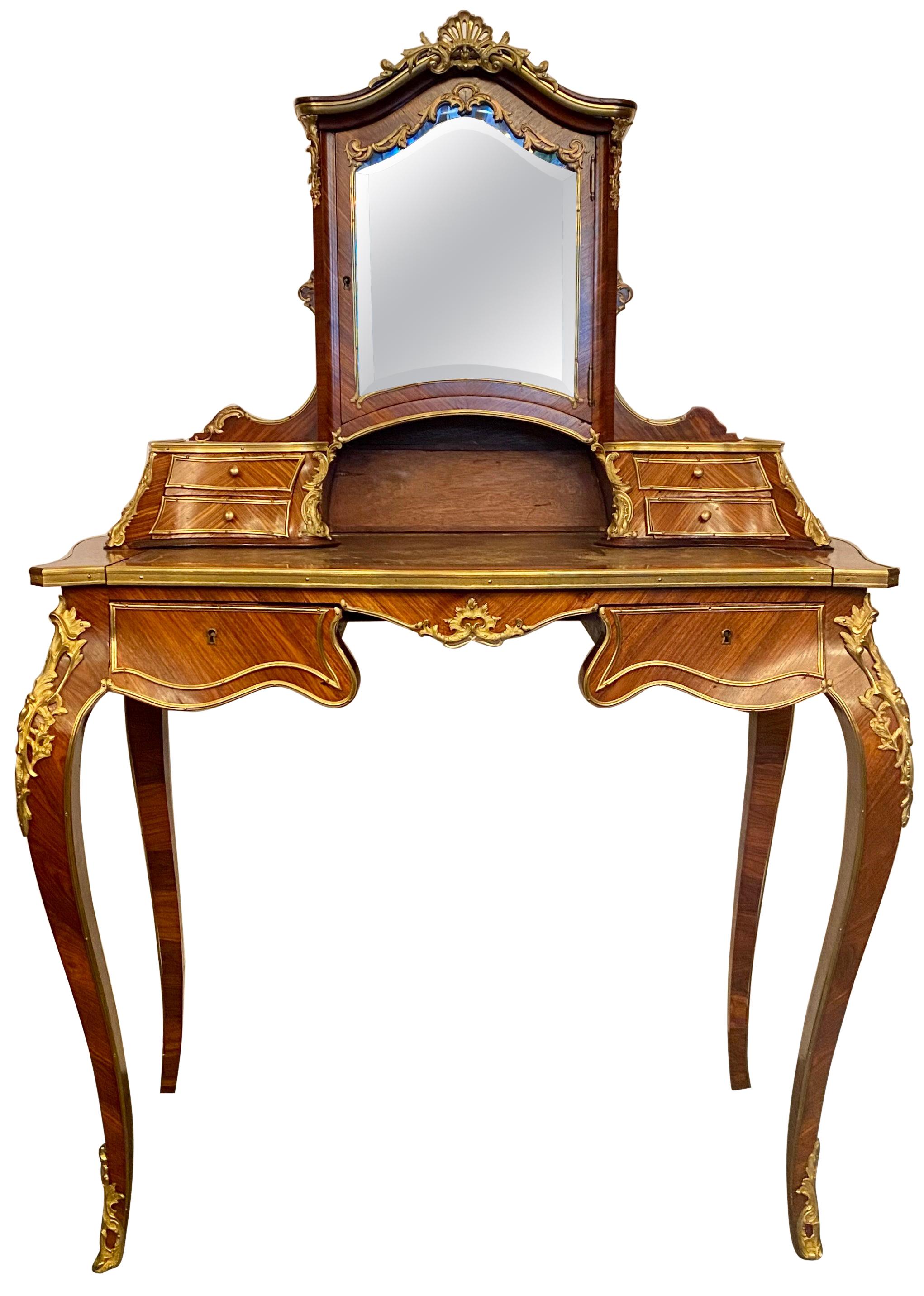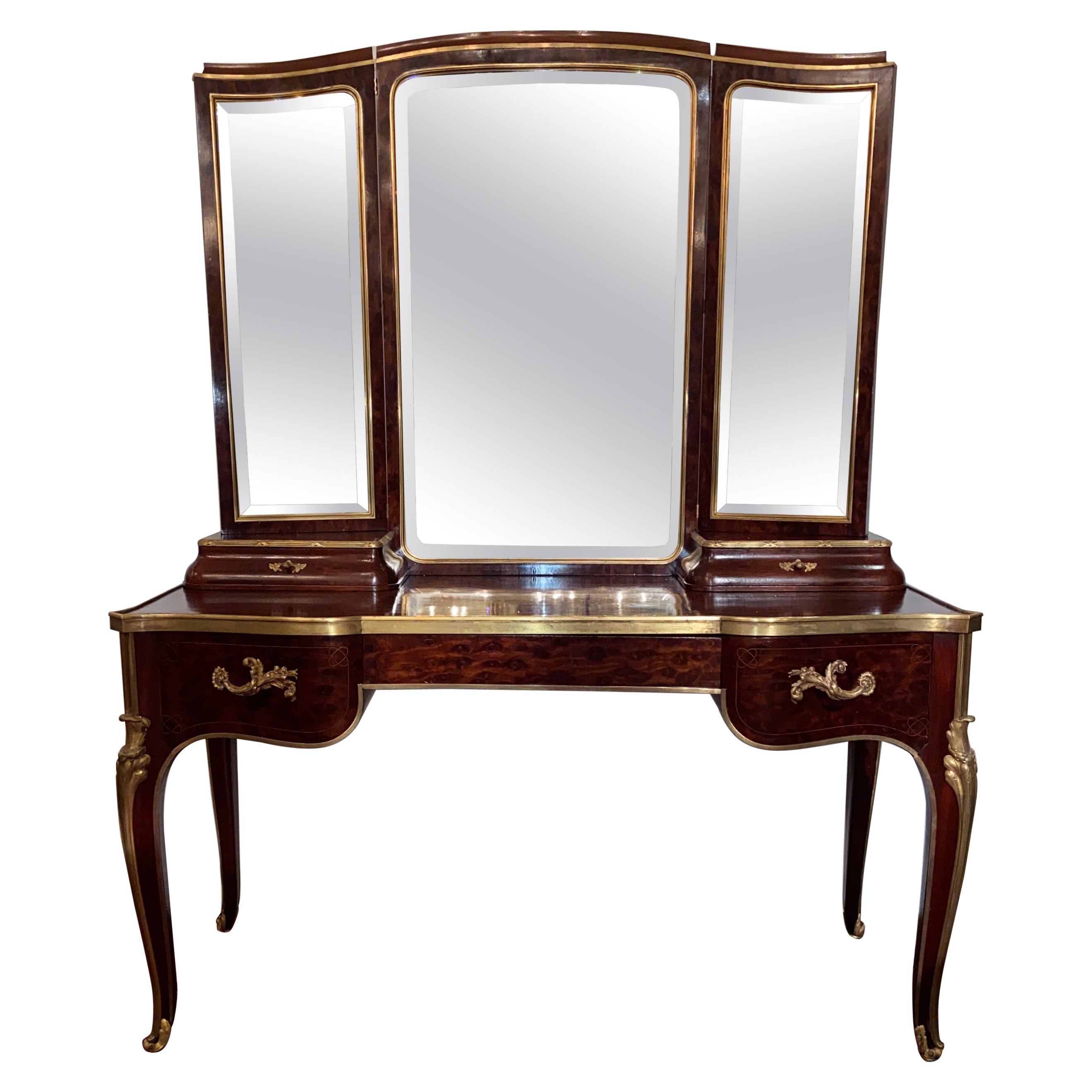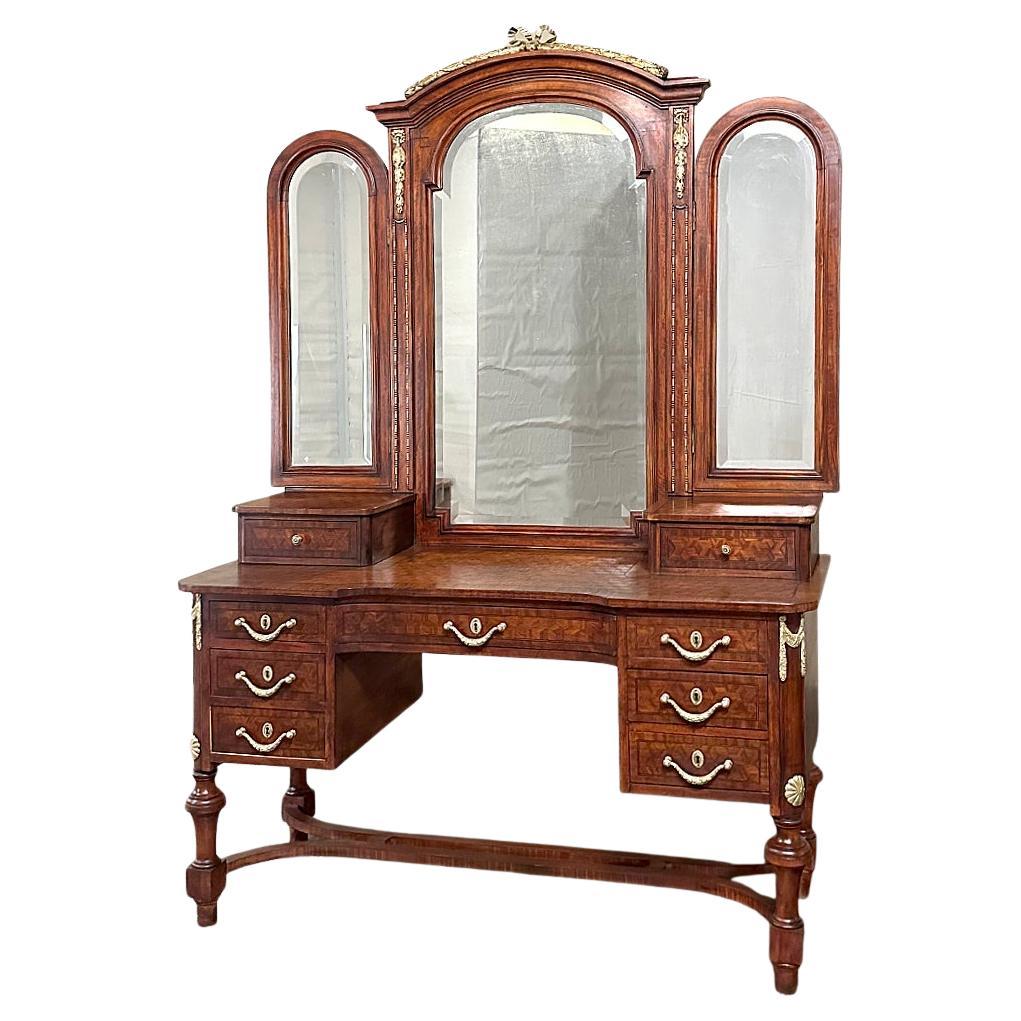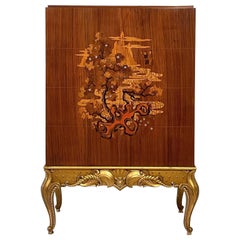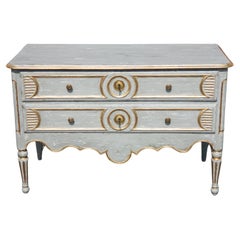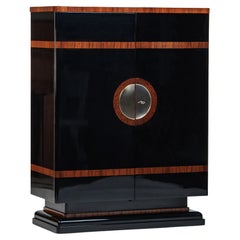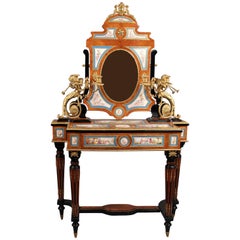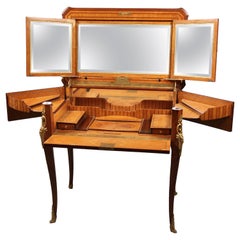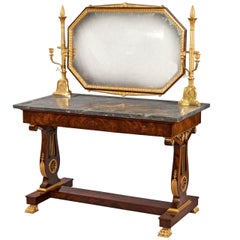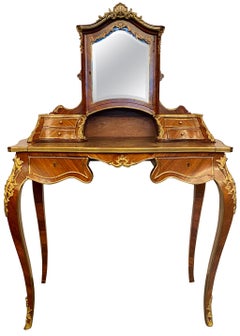Items Similar to Russian Empire Dressing Table with Mahogany Carvings and Gilt Bronzes
Want more images or videos?
Request additional images or videos from the seller
1 of 12
Russian Empire Dressing Table with Mahogany Carvings and Gilt Bronzes
$63,386.35
£46,761.63
€53,000
CA$87,748.39
A$95,144.94
CHF 50,492.30
MX$1,171,830.95
NOK 625,820.22
SEK 590,630.40
DKK 403,517.19
About the Item
The desk body is made of pine and oak with a Karelian birch veneer and the mirrored base is supported by four curved feet, embellished by an entwined patinated bronze snake with a gilt head and tail. The pad feet are supported by ebonized mahogany floor plates.
The middle portion consists of five small drawers and a large desk drawer and within a manufactured mahogany interior with seven compartments and eight secret compartments as well as two movable elements, one of which is covered with velvet. The lower drawers have gilt gooseneck fittings.
The mirror attachment includes a mechanism for taking the mirror plate vertically out and up to 180 degrees, which can, in turn, be fixed in almost any position. This mirror is flanked by two carved mahogany phoenixes with gilt heads and feet, and on the reverse side there are two more secret compartments in the lower area of the right as well as the left foot of the base.
The Poudreuse Secretary is an exceptional example of Russian furniture of the first quarter of the nineteenth century. The depiction and symbolic arrangement of the remarkable bronze snakes and the carved phoenix is typical of the style of the important Russian architect Andrey Voronikhin (1759-1814). As well, this Poudreuse Secretary Desk has as well a similar structure to a dressing table made by the celebrated cabinetmaker (ebéniste) Heinrich Gambs (1765–1831) and is similar to pieces produced by these two leading figures. As Antoine Chenevière notes: “It should not be forgotten that the great majority - if not all - of these pieces (Gamb’s) are unsigned. However, it is sometimes possible to identify the work of a particular craftsman.”
Poudreuse is a French name for a table originally created in the seventeenth century for cosmetics. As a retreat and dressing room for women, boudoirs were often very elaborate and fitted with high-quality furnishings and a remarkable Poudreuse desk like this one would be a custom and central furnishing of such an elegantly appointed room. The outstanding quality of this Poudreuse Desk indicates the original owner was of very high social standing. As well, while Russian furniture art was strongly influenced by France and Germany and there were many imports to Russia throughout the eighteenth century, it should also be noted that the local cabinetmakers quickly learned to produce furniture including H. Gambs and A. Voronikhin’s exceptional products either on behalf of the Tsar family or other families of aristocratic descent.
As we can see from a number of extant drawings, when designing and executing their projects, during this period, Russian architects paid special attention to the furnishings and the integration into their overall design concept of the rooms. Specifically, Voronikhin’s work is described as follows: “He built numerous buildings in and around St. Petersburg, and he always took great care in the interior decoration, producing large numbers of drawings for objets d’art and furniture.”1 Chenevière also describes the collaboration between Heinrich Gambs, one of the most important Russian cabinetmakers and the key architect and designer Voronikhin: “From about 1805 he made furniture for the designs of Voronikhin.”
Furthermore, in reference to the motifs seen in this Poudreuse Desk, Voronikhin’s designs often included swans and snakes particularly in the allegorical depiction of snakes and birds together.. A particularly striking comparison is made with the similar designs of snakes on a chair designed by Voronikhin compared to the snakes of this Poudreuse Desk. As well, there is also similarity seen in this desk’s carved mahogany phoenix feathers and the feathered armrests of a chair designed by Voronikhin. Overall, the high quality of the sculptural embellishment adds to the exceptional quality of this piece.
Chenevière makes note of the complex process of constructing such a piece of ornate furnishing: “The workshop of H. Gambs has several different sections responsible for the different stages of furniture-making. One craftsman would be in charge of constructing the carcase and applying the veneer, another would cut out the brass motifs and friezes and fix them on the prepared base of dark wood, a third would be responsible for the casting, and applying or patination of the bronze ornaments, a fourth would devise and install secret compartments and mechanical devices, and so on.“
As well it has been observed by N.V Ugleva that “the workshop of Heinrich Gambs was famous for furniture with secret hiding places.”2 And indeed, there are various mechanical secret hiding places in this Poudreuse Desk interior, in the base of the mirror and at the back of the base. The fold-out dressing mirror, which rotates vertically, as well as on its own axis and can be fixed at a desired position, is another indication of the involvement of the workshop of Gambs.
Such specialized craftsmanship likely also led to the rare symbolic detail of the pearl necklace of gooseneck-shaped fitting. Ugleva explains: “The pearl necklace on the bird’s neck, however, is an extremely rare item [...]. First, there is a well-known tradition of the House of Romanov [...] there was a string of pearls as a symbol of innocence and girlish purity.” This motif, of course, points to questions about the original owner of the desk.
Finally, it should be observed that until around 1810, mahogany wood was mostly used for the production of high-quality furniture including construction, carvings, interior work, and veneer work. The stylistic and structural construction during this time was rather strict and straightforward. Both stylistic features changed greatly in the following years.
Chenevière notes: «Gradually, however, a new tendency can be discerned: to give precedence to natural wood,” Mahogany or indigenous, like “Karelian birch” and “bronze ornaments” more and more. This was to be the dominant trait of the years 1810-1825».
Likewise, this Poudreuse Desk is made of mainly native woods used in Russia (the blind is made of pine and oak). The desk has a veneer characteristic of Russia Karelian birch: “Nowadays it has become a symbol of the nations’ furniture production”.
Overall, the design emphasizes individual architectural elements (such as the pedestal, base, the central section, and mirror). As well, the contrast of the warm tone of the Karelian Birch with the ebonized wood strip and mahagony moldings provide a sense of ornate depth and richness. According to Chenevière this approach was often used during this period: “In addition, they use ebony or ebonized woods as a means of heightening the warmth of natural wood, contrasting the black and honey colors.”
Furthermore, the carved phoenix, drawers, and the intricately crafted interior are made of mahogany wood and the desk is decorated with four elaborate patinated bronze serpents with gilt heads and tales. As Chenevière observes such combinations had a «Curiosity value - tapestry panels, for example, which came into fashion in about 1805, or indigenous woods such as stained birch»1 This combination of Russian wood and ornate gilded and bronze ornaments date this Poudreuse desk to the end of the first part (1800 and 1810) and the beginning of the second part (1810-1825) of the Russian Empire.
Made during the height of Russian furniture production, this exceptional Poudreuse Secretary showcases the style and characteristics of furniture produced in the first and second half of the Russian Empire, including a high level of craftsmanship, period decoration, and material. Such furnishings were made for members of the Imperial Court and aristocracy by Gambs and Voronikhin and other workshops in this style.
Footnotes: 1. Chenevière Antoine. Russian Furniture: The Golden Age, 1780-1840. Weidenfeld & Nicholson, (1988), pp. 38, 51, 103, 143, 155, 165, 177, 182, 195. 2. Ugleva Natalja Vladimirowna. Furniture of Heinrich Gambs – In The Hermitage Collection. The State Hermitage Museum. St. Petersburg: The State Hermitage Publishers, (2016), pp. 41-43.
- Similar to:Andrey Voronikhin (Designer)
- Dimensions:Height: 61.42 in (156 cm)Width: 37.01 in (94 cm)Depth: 18.9 in (48 cm)
- Style:Empire (Of the Period)
- Materials and Techniques:
- Place of Origin:
- Period:
- Date of Manufacture:1810
- Condition:Refinished. Wear consistent with age and use. beautiful restored condition with shellack finish.
- Seller Location:Vienna, AT
- Reference Number:1stDibs: LU1050627080472
About the Seller
4.5
Vetted Professional Seller
Every seller passes strict standards for authenticity and reliability
Established in 2007
1stDibs seller since 2014
223 sales on 1stDibs
Typical response time: <1 hour
- ShippingRetrieving quote...Shipping from: Vienna, Austria
- Return Policy
Authenticity Guarantee
In the unlikely event there’s an issue with an item’s authenticity, contact us within 1 year for a full refund. DetailsMoney-Back Guarantee
If your item is not as described, is damaged in transit, or does not arrive, contact us within 7 days for a full refund. Details24-Hour Cancellation
You have a 24-hour grace period in which to reconsider your purchase, with no questions asked.Vetted Professional Sellers
Our world-class sellers must adhere to strict standards for service and quality, maintaining the integrity of our listings.Price-Match Guarantee
If you find that a seller listed the same item for a lower price elsewhere, we’ll match it.Trusted Global Delivery
Our best-in-class carrier network provides specialized shipping options worldwide, including custom delivery.More From This Seller
View AllArt Deco Cabinet by Maurice Dufrene, France, c. 1940
By Maurice Dufrêne, La Maitrise
Located in Vienna, AT
Wonderful Art Deco Cabinet designed by Maurice Dufrene and manufactured by La Maitrise around 1940. The cabinet is made from rosewood and has mother of pearl inlays.
Rosewood-vene...
Category
Vintage 1940s French Art Deco Cabinets
Materials
Mother-of-Pearl, Rosewood
18th Century French Country Provincial Grey White and Gold Painted Commode
Located in Vienna, AT
This extraordinary antique provincial commode or chest of drawers is made from Oak wood in France at the end of the 18th Century. The chest has two drawers, each with a separate work...
Category
Antique Late 18th Century French French Provincial Commodes and Chests o...
Materials
Brass
$3,591 Sale Price
40% Off
19th Century Antique French Farmhouse, Painted Louis XVI Style Dining Room Table
Located in Vienna, AT
This extraordinary antique Louis XVI style painted dining room table was made in France around 1880. The tabletop has two circumferential grooves on the edge of the tabletop, a carve...
Category
Antique 1880s French Louis XVI Dining Room Tables
Materials
Oak
$10,343 Sale Price
20% Off
Swedish Scandinavian Art Deco Cabinet Attr. Otto Schulz
By Otto Schulz
Located in Vienna, AT
Beautiful Swedish Art Deco cabinet attributed to the designer Otto Schulz. The cabinet is veneered with ebonized birch, flamed birch and maccasar wood. In the middle of the front the...
Category
Vintage 1930s Swedish Art Deco Cabinets
Materials
Nickel, Silver
Austrian Midcentury Walnut and Brass Wall Shelf by Oswald Haerdtl
By Oswald Haerdtl
Located in Vienna, AT
This beautiful rare and substantial Austrian midcentury Walnut and rass wall self was designed by Oswald Haerdtl, one of the most important post War Austrian Architects, in Vienna 19...
Category
Vintage 1950s Austrian Mid-Century Modern Bookcases
Materials
Brass
Small Scandinavian Floating Teak Chest of Drawers
By Kai Kristiansen
Located in Vienna, AT
This amazing Scandinavian Modern Teak Floating shelve was designed and manufactured in Denmark in the 1960s. it can be wall mounted and used as a bedside table or nightstand or as wa...
Category
Vintage 1960s Danish Scandinavian Modern Commodes and Chests of Drawers
Materials
Teak
$459 Sale Price
20% Off
You May Also Like
Beautiful Late 19th Century Gilt Bronze and Sevres Style Dressing Table
Located in Long Island City, NY
A Beautiful Late 19th Century Gilt Bronze Mounted Louis XVI Sèvres Style Dressing Table
This wonderful and rare table is mounted by over twenty three individual porcelain plaques de...
Category
Antique Late 19th Century French Belle Époque Dressers
Materials
Bronze, Ormolu
$36,000 Sale Price
20% Off
Rare Late 19th Century Dressing Gilt Bronze Mounted Dressing Table
Located in Long Island City, NY
A Rare Late 19th Century Louis XV Style Gilt Bronze Mounted Dressing Table
The top lifts to reveal a beautifully fitted and inlaid interior with swing out panels and beveled mirror....
Category
Antique Late 19th Century French Belle Époque Dressers
Materials
Bronze, Ormolu
19th Century French Empire Mahogany, Gilt and Marble Topped Dressing Table
By François-Honoré-Georges Jacob-Desmalter
Located in London, GB
Constructed using a fine Honduras mahogany with gilt highlights, Bleu Tarquin marble and richly dressed with fire gilt ormolu mounts of the highest quality. The table of lyre end sup...
Category
Antique 19th Century French Empire Vanities
Materials
Marble, Ormolu
Antique French Rosewood and Gold Bronze Writing Desk or Vanity, circa 1880-1890
Located in New Orleans, LA
Antique French rosewood and gold bronze writing desk or vanity, circa 1880-1890.
30" high to writing surface. 51" high to top of mirror
This piece is all original to when we purcha...
Category
Antique Late 19th Century French Desks
Materials
Bronze
Antique French Louis XVI Bronze D 'Ore and Mahogany Coiffeuse Vanity, Circa 1890
Located in New Orleans, LA
Antique French Louis XVI Bronze D 'Ore Mounted Mahogany Coiffeuse Vanity, Circa 1890.
Category
Antique Late 19th Century French Louis XVI Vanities
Materials
Bronze
19th Century French Louis XVI Mahogany Marquetry Vanity
Located in Dallas, TX
19th Century French Louis XVI Mahogany Marquetry Vanity will make the perfect finishing touch for your bedroom! Crafted from exotic imported mahogany, the surfaces and facade are fi...
Category
Antique 1890s French Louis XVI Dressers
Materials
Brass
More Ways To Browse
Antique Russian Furniture
Antique Russian Bronze
Early 19th Century Dressing Table
Russian Oak
Carved Wood Mirror With Birds
Early 19th Century Secretary Desk
Oak Desk Table One Drawer
Side By Side Secretary Desk
19th Century Oak Dresser
Carved 1 Piece Wood Chair
Antique Desk Oak Desks And Secretaries
Antique Russian Table
Antique Chair Armrest
Carved Snake
Pad Feet Mahogany Side Table
Carved Wood Dresser With Mirror
Oak Dressing Table
Rotating Mirror
